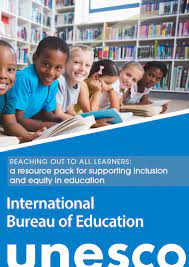Reaching out to all learners: A resource pack for supporting inclusion and equity in education

The resource pack Reaching Out to All Learners focuses on a what is arguably the greatest challenge facing education systems around the world, that of finding ways of including and ensuring the learning of all children in schools. In economically poorer countries this is mainly about the millions of children who are not able to attend formal education. Meanwhile, in wealthier countries many young people leave school with no worthwhile qualifications, some choose to drop out since the lessons seem irrelevant, and others are placed in special classes or schools away from mainstream education. UNESCO estimates that girls aged 12-17 are at particular risk of dropping out of school in low- and lower-middle income countries, whereas boys are more at risk in upper-middle and high-income countries.
Recently, teachers have faced further unprecedented challenges as they seek to find ways of ensuring quality education for all their students within the context of the COVID-19 pandemic. Whilst the nature of these challenges varies depending on the location, a common concern is with those students who are known to be vulnerable to marginalization or exclusion, such as those from the poorest households, refugees and those in conflict situations, ethnic and linguistic minorities and indigenous backgrounds, and children with disabilities. It follows that efforts to ensure educational recovery after the pandemic must be based upon the principles of inclusion and equity.
More
Year:
Organisation:
The UNESCO International Bureau of Education (UNESCO-IBE)
Keywords:
inclusion in education, educational recovery, Covid-19 pandemic, school closures
Marginalized & Vulnerable group:
All
Topic:
System wide approach
Level of Education:
Across the education sector
Type of Resources:
International and Regional Instruments
Country/Region:
All, Africa, Arab States, Asia & the Pacific, Europe & North America, Latin America & the Caribbean
Language of Publication:
English